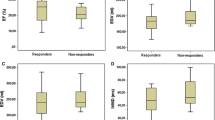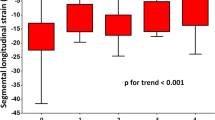Abstract
Purpose: Myocardial imaging with I-123-beta-methyl-p-iodophenyl-methylpentadecanoic acid (BMIPP) is useful for predicting the outcome of patients with hypertrophic cardiomyopathy (HCM). But its usefulness in asymptomatic patients is unclear. Materials and methods: Eighteen patients with asymptomatic HCM were examined with BMIPP and exercise stress perfusion imaging and then followed for 4.0 ± 0.8 years. Extent of the defect (total defect score, TDS) and myocardial uptake of BMIPP (%uptake) were calculated to evaluate the BMIPP images. Results: In the first study abnormal findings in the BMIPP and perfusion images were detected of 67 and 22% of the patients, respectively. In the second BMIPP study, the TDS had increased (2.1 ± 2.7 to 4.1 ± 4.9, p < 0.005) and the %uptake had decreased (5.67 ± 0.88% to 4.81 ± 0.91%, p < 0.001), but there were no differences in myocardial perfusion between the first and second study. Exertional dyspnea developed in 17% of the patients, and they were among the one third of the patients with the greatest reduction of %uptake. This group also showed deterioration of left ventricular (LV) %fractional shortening and LV volume in the second study. Conclusions: Abnormal findings on BMIPP images were frequently observed in patients with asymptomatic HCM, and these abnormal findings progressed with time. The greater reduction of %uptake during the follow-up period reflects the deterioration of the LV function.
Similar content being viewed by others
References
Maron BJ, Bonow RO, Cannon RO III, Leon MB, Epstein SE. Hypertrophic cardiomyopathy. Interrelations of clinical manifestations, pathophysiology, and therapy. New Eng J Med 1987; 316: 844–852.
Wigle ED, Rakowski H, Kimball BP, Williams WG. Hypertrophic cardiomyopathy. Clinical spectrum and treatment. Circulation 1995; 92: 1680–1692.
Spirito P, Seidman CE, McKenna W, Naron BJ. Clinical course and prognosis of hypertrophiccardiomyopathy in an outpatient population. New Eng J Med 1997; 336: 775–785.
Wynne J, Braunwald E. The cardiomyopathies and myocarditides: toxic, chemical, and physical damage to the heart. In: Braunwald E editor Heart Disease: A Textbook of Cardiovascular Medicine. 4th ed. Philadelphia: WB Saunders, 1992; 1394–1450.
Spirito P, Chiarella F, Carratino L, Berriso MZ, Bellotti P, Vecchio C. Clinical course and prognosis of hypertrophiccardiomyopathy in an outpatient population. New Eng J Med 1989; 320: 749–755.
Yutani C, Imakita M, Ishibashi-Ueda H, et al. Three autopsy cases of progression to left ventricular dilatation in patients with hypertrophic cardiomyopathy. Am Heart J 1985; 109: 545–553.
Spirito P, Maron BJ, Bonow RO, Epstein SE. Occurrence and significance of progressive left ventricular wall thinning and relative cavity dilatation in patients with hypertrophic cardiomyopathy. Am J Cardiol 1987; 60: 123–129.
Maron BJ, Olivotto I, Spirito P, et al. Epidemiology of hypertrophic cardiomyopathy-related death: revisited in a large non-referral-based patient population. Circulation 2000; 102: 858–864.
Bingisser R, Candinas R, Schneider J, Hess OM. Risk factors for systolic dysfunction and ventricular dilatation in hypertrophic cardiomyopathy. Int J Cardiol 1994; 44: 225–233.
Knapp FF, Ambrose KR, Goodman MM. New radioiodinated methyl-branched fatty acids for cardiac study. Eur J Nucl Med 1986; 12: S39–S44.
Tamaki N, Kawamoto M, Yonekura Y, et al. Regional metabolic abnormality in relation to perfusion and wall motion in patients with myocardial infarction: assessment with emission tomography using an iodinated branched fatty acid analog. J Nucl Med 1992; 33: 659–667.
Knapp FF, Franken P, Kropp J. Cardiac SPECT with iodine-123-labeled fatty acids: evaluation of myocardial viability with BMIPP. J Nucl Med 1995; 36: 1022–1030.
Kurata C, Tawarahara K, Taguchi T, et al. Myocardial emission computed tomography with iodine-123-labeled beta-methyl-branched fatty acid in patients with hypertrophic cardiomyopathy. J Nucl Med 1992; 33: 6–13.
Ohtsuki K, Sugihara H, Umamoto I, Nakamura T, Nakagawa T, Nakagawa M. Clinical evaluation of hypertrophic cardiomyopathy by myocardial scintigraphy using 123Ilabeled 15-(p-iodophenyl)-3-R, S-methylpentadecanoic acid(123I-BMIPP). Nucl Med Commun 1994; 15: 441–447.
Matuo S, Nakamura Y, Takahashi M, Mitunami K, Kinoshita M. Myocardial metabolic abnormalities in hypertrophic cardiomyopathy assessed by iodine-123-labeled beta-methyl-branched fatty acid myocardial scintigraphy and its relation to exercise-induced ischemia. Jpn Circ J 1998; 62: 167–172.
Nishimura T, Nagata S, Uehara T, et al. Prognosis of hypertrophic cardiomyopathy: assessment by 123I-BMIPP (bmethyl-p-(123I)iodophenyl pentadecanoic acid) myocardial single photon emission computed tomography. Ann Nucl Med 1996; 10: 71–78.
Yoshida M, Nakamura Y, Fukuhara T, et al. Prognostic determinants of hypertrophic cardiomyopathy, the results of the Shiga Cardiomyopathy Study. Jpn Cir J 1995; 59: 745–753.
Shimizu M, Ino H, Okeie K, et al. Cardiac dysfunction and long-term prognosis in patients with nonobstructive hypertrophic cardiomyopathy and abnormal (123)I-15-(p-Iodophenyl)-3(R,S)-methylpentadecanoic acid myocardial scintigraphy. Cardiology 2000; 93: 43–49.
Saolo S, Maron BJ, Bonow RO, Epstein SE. Occurrence and significance of progressive left ventricular wall thinning and relative cavity dilatation in hypertrophic cardiomyopathy. Am J Cardiol 1987; 59: 123–129.
Cecchi F, Olivotto I, Lazzeroni E, et al. Clinical course of hypertrophic cardiomyopathy in a non selected population. The Experience of the Italian Multicenter Cardiomyopathy Study. G Ital Cardiol 1997; 27: 1133–1143.
Berman DS, Kiat HS, Van Train KF, Germano G, Maddahi J, Friedman JD. Myocardial perfusion imaging with technetium-99m-sestamibi: comparative analysis of available imaging protocols. J Nucl Med 1994; 35: 681–688.
Hoe J, Powers J, Iskandrian AE. Exercise-rest same-day SPECT sestamibi imaging to detect coronary artery disease. J Nucl Med 1997; 38: 200–203.
Narita M, Kurihara T. Fatty acid metabolism in patients with idiopathic dilated cardiomyopathy: characteristics and prognostic implications. J Cardiol 1995; 25: 223–231.
Narita M, Kurihara T, Shindoh T, Honda M. Clinical significance of myocardial 123I-BMIPP imaging in patients with myocardial infarction. Kakuigaku 1997; 34: 177–187.
Torizuka K, Yonekura Y, Nishimura T, et al. The phase 1 study of b-methyl-p(123I) iodo-phenyl-pentadecanoic acid (123I-BMIPP). Kakuigaku 1991; 28: 681–690.
Tsuchimoto S, Tamaki N, Kawamoto M, et al. Myocardial uptake ratio of Iodine-123 labeled beta-methyl iodophenylpentadecanoic acid (123I-BMIPP) in relation to the concentration of substrate of energy. Kakuigaku 1995; 32: 579–586.
Sahn DJ, DeMaria A, Kisslo J, Weyman A. Recommendation regarding quantitation in M-mode echocardiography: result of a survey of echocardiographic measurements. Circulation 1978; 58: 1072–1083.
Groven-McKay M, Schwaiger M, Krivokapich J, Kerloff JK, Phelps ME, Scherbert HR. Regional myocardial blood flow and metabolism at rest in mildly symptomatic patients with hypertrophic cardiomyopathy. J Am Coll Cardiol 1989; 13: 317–324.
Hina K, Kusachi S, Iwasaki K, et al. Progression of left ventricular enlargement in patients with hypertrophic cardiomyopathy: incidence and prognostic value. Clin Cardiol 1993; 16: 403–407.
Ishiwata S, Nishiyama S, Nakanishi S, et al. Natural history of 82 patients with hypertrophic cardiomyopathy: follow-up for over ten years. J Cardiol 1991; 21: 61–73.
Author information
Authors and Affiliations
Rights and permissions
About this article
Cite this article
Narita, M., Kurihara, T. Is I-123-beta-methyl-p-iodophenyl-methylpentadecanoic acid imaging useful to evaluate asymptomatic patients with hypertrophic cardiomyopathy?. Int J Cardiovasc Imaging 19, 499–510 (2003). https://doi.org/10.1023/B:CAIM.0000004262.48898.5d
Issue Date:
DOI: https://doi.org/10.1023/B:CAIM.0000004262.48898.5d




